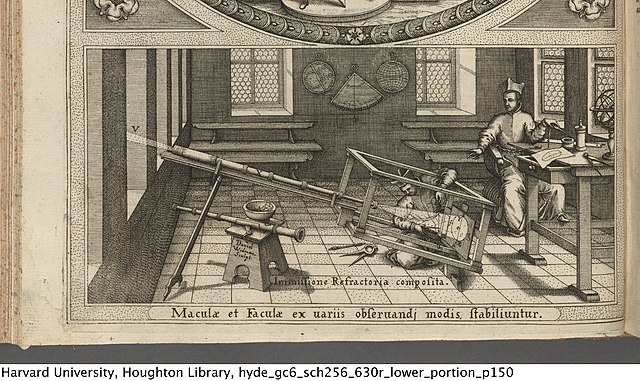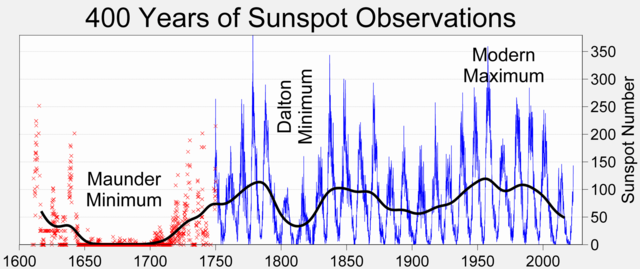
Image 1 Caption: "Christoph Scheiner (1573--1650) and a fellow Jesuit Catholic clerical scientist trace sunspots in Rome, Italy in about 1625." (Slightly edited.)
Features:
- Christoph Scheiner (1573--1650)
was one of pioneers of the helioscope
or
camera obscura telescope
(which makes use of
pinhole projections and
a telescope)
in order to do visual astronomy
of the Sun without
eye damage.
- Sunspots had
been observed since before 800 BCE
in China, but
they were still generally unknown in
Europe at the dawn of
the early telescopic era
(1608--1700)
in 1608
(see Wikipedia: Sunspot: History;
Wikipedia:
History of the telescope: Invention).
Early observations may have been by looking at the Sun through clouds and/or at sunrise/sunset. Such observations will have caused eye damage. It is NOT clear from Wikipedia when camera obscura (a darkened room with aperture for pinhole projection) was first used to observe sunspots. Johannes Kepler (1571--1630) used it in 1607 just before the early telescopic era (1608--1700) (see Galileo Project: Science: Sunspots: scroll down ∼ 20 %).
- The first telescopic discovery of
sunspots
was in 1610
December by
Thomas Harriot (c.1560--1621)
and then there was a second independent
discovery in
1611
March
by Johannes Fabricius (1587--1616)
and his father
David Fabricius (1564--1617).
However, Harriot's
discovery was
NOT reported ?????
in the
early telescopic era
(1608--1700)
and
Johannes Fabricius'
publication of this discovery in
22-page
pamphlet
De Maculis in Sole observatis (1611)
was NOT widely even at his death in
1616.
So the widely known
independent discoveries
by Christoph Scheiner (1573--1650)
(reported in Christoph Scheiner (1573--1650),
De Maculis solaribus
et stellis circa Iovis errantibus accuratior Disquisitio (1612))
and Galileo (1564--1642)
(reported in Gallieo (1564--1642),
Three Letters on Sunspots, 1612)
achieved more recognition before
1616
(see Wikipedia: Sunspot: History).
Apparently, some of these early observations of sunspots were done in looking at the Sun through the telescope, but with old way of looking through clouds or at sunrise/sunset since Benedetto Castelli (1578--1643) seems to have invented pinhole projection with a telescope only in 1612 (see Galileo Project: Science: Sunspots: scroll down ∼ 40 %).

- Image 2 Caption: Observations of sunspots in 1612 by Christoph Scheiner (1573--1650) reported in Christoph Scheiner (1573--1650), De Maculis solaribus et stellis circa Iovis errantibus accuratior Disquisitio (1612).
- For sunspots as they would have been seen, more or less, by the early telescopic era astronomers (1608--1700) see figure below (local link / general link: sun_white_light.html).
- Image 3 Caption: "The graph shows the sunspot counts since the early telescopic era (1608--1700)." The sunspot count varies approximately periodically with solar cycle (11 years on average; 9 to 14 year range). For more information, see Sun file: sunspots_solar_cycle.html.
- See also Sun keywords below (local link / general link: keywords_sun.html):
- EOF
- Solar atmosphere videos below (local link / general link: solar_atmosphere_videos.html):
- Image 2 Caption: Observations of sunspots in 1612 by Christoph Scheiner (1573--1650) reported in Christoph Scheiner (1573--1650), De Maculis solaribus et stellis circa Iovis errantibus accuratior Disquisitio (1612).
-
Images:
- Credit/Permission:
Christoph Scheiner (1573--1650),
anonymous
engraver in
Rosa Ursina sive Sol
(1626--1630)
(uploaded to Wikimedia Commons
by User:Rob at Houghton,
2014) /
Public domain.
Image link: Wikimedia Commons: File:Scheiner Viewing Sunspots 1625 - uncropped.jpg.
- Credit/Permission: Christoph Scheiner (1573--1650), engraver Alexander Mair (1559--1617) in De Maculis solaribus et stellis circa Iovis errantibus accuratior Disquisitio (1612) (uploaded to Wikimedia Commons by User:Mr.saturn12, 2018) / Public domain.
Image link: Wikimedia Commons: File:Scheiner plate observation (3).png.
- Credit/Permission: © Robert A. Rohde (AKA User:Dragons flight), 2013 / Creative Commons CC BY-SA 3.0.
Image link: Wikimedia Commons: File:Sunspot Numbers.png.
- Credit/Permission: Christoph Scheiner (1573--1650), engraver Alexander Mair (1559--1617) in De Maculis solaribus et stellis circa Iovis errantibus accuratior Disquisitio (1612) (uploaded to Wikimedia Commons by User:Mr.saturn12, 2018) / Public domain.
File: Sun file: sunspots_history.html.
